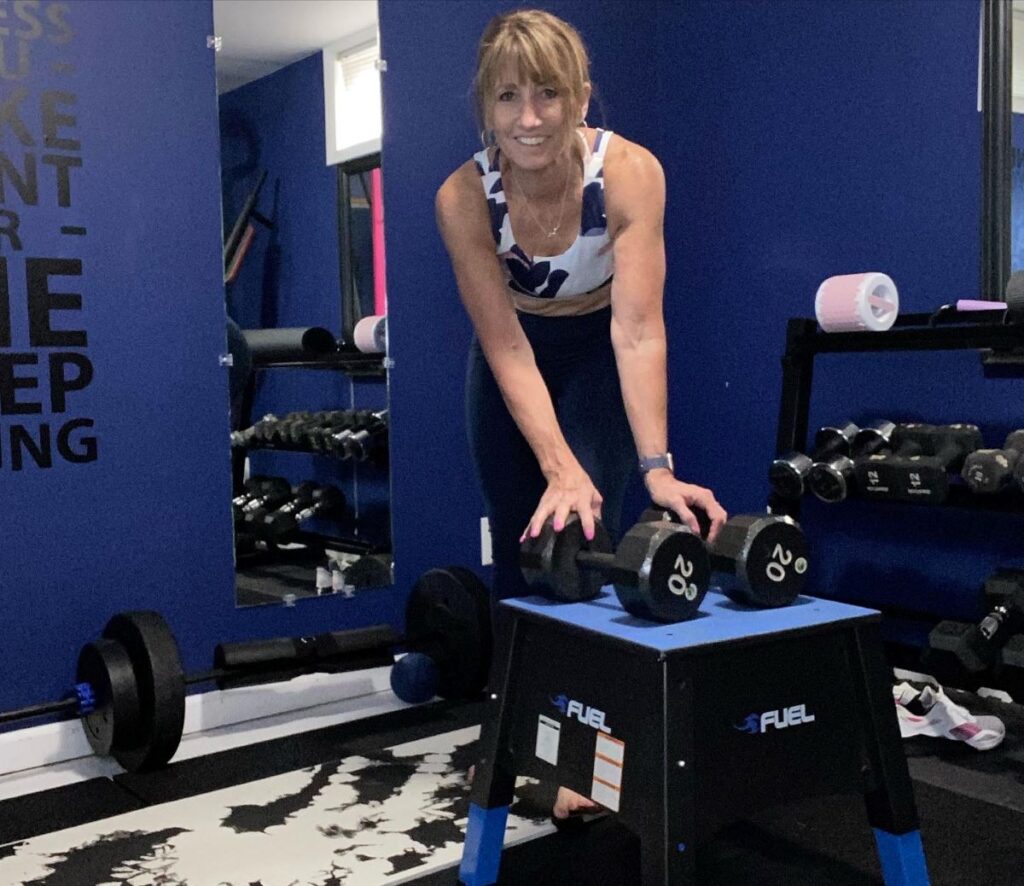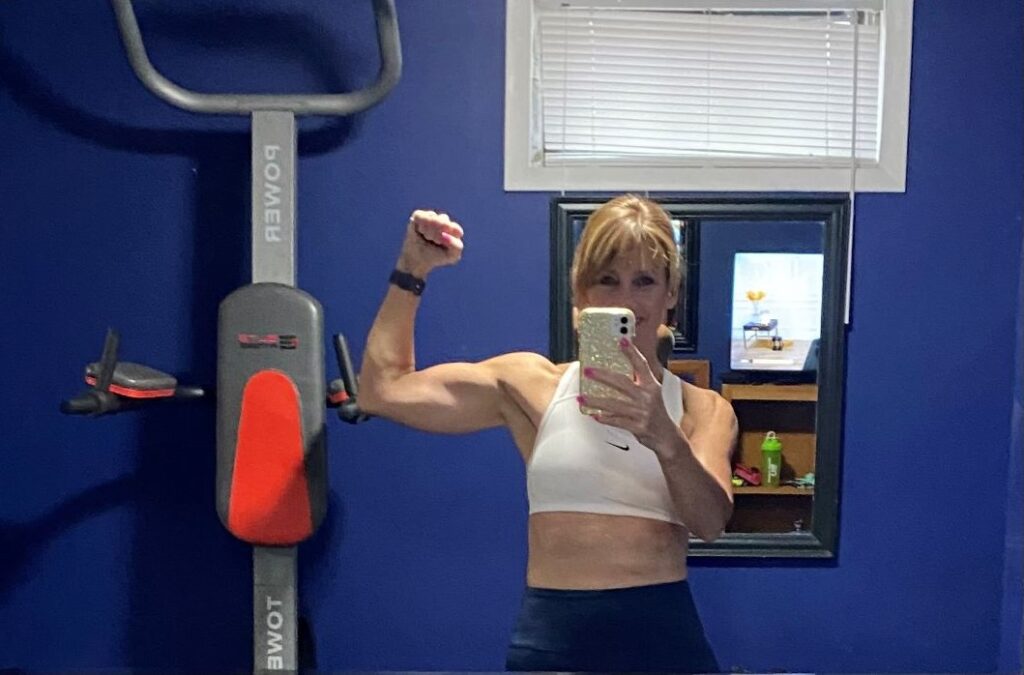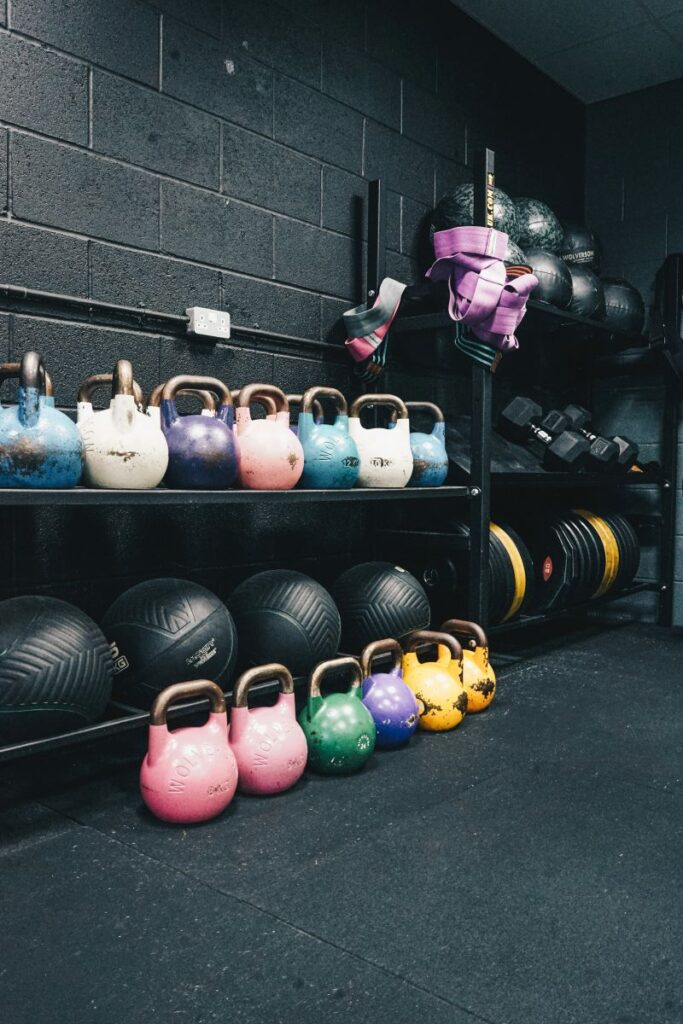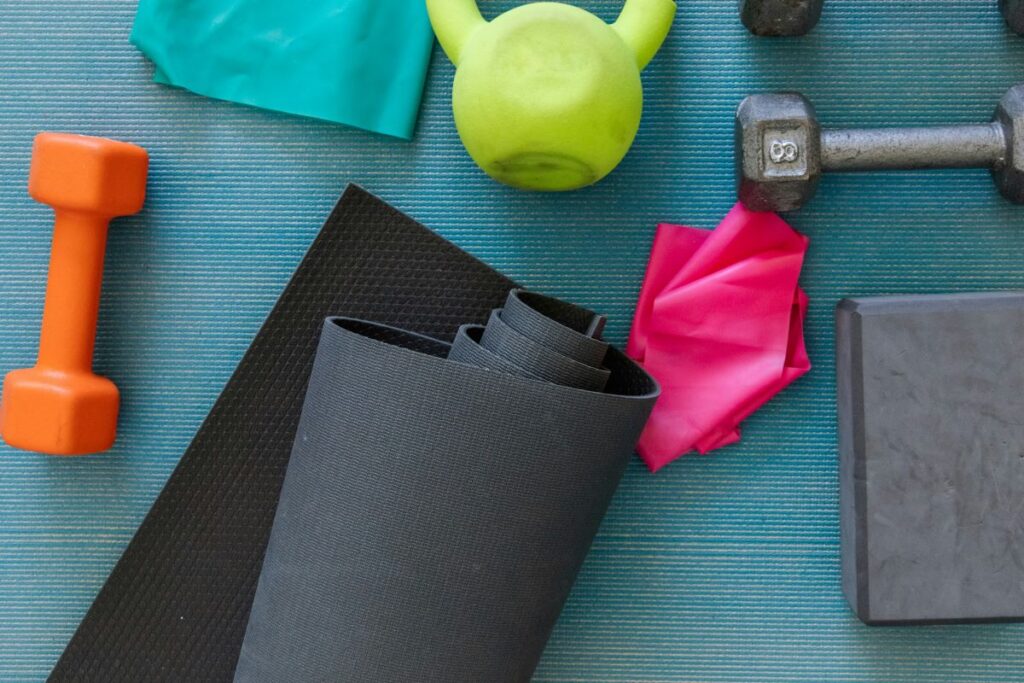How to Start Weight Training for Women 60+: Embrace Strength and Confidence!
Are you looking to start a fitness journey or take your current routine up a notch?
Weight training might just be the thing that you are looking for.
Don’t worry if the idea of pumping iron sounds intimidating.
I can tell you that weight training for women, even us 60 somethings, is not only possible but also incredibly empowering.
Age is merely a number when it comes to strength and fitness.
You’re not just working out; you’re redefining what your body can do.
It’s time to break free from stereotypes, embrace empowerment, and show off your physical and mental resilience.
So grab your dumbbells, find your favorite workout playlist, and let’s dive headfirst into the world of weight training for a sexy, strong body — even in our 60’s.
Get ready to lift, laugh, and live your absolute best life!

This post may contain affiliate links. If you make a purchase using my link, I may earn a commission at no extra cost to you.
Understanding Age-Related Changes
As we age, our bodies undergo significant changes. We lose muscle mass, which can lead to decreased strength and stability.
According to some studies, women can lose up to 5% of their muscle mass each decade after 30. I think that is just crazy!
Why does this happen? Well, of course, there are those wonderful hormone changes that we go through – ever heard of menopause??
When our estrogen levels decrease it affects our bone density.
The good news? Strength training workouts can actually help counteract these changes by building muscle and improving bone health.
READ MORE: Weight lifting at older ages builds muscle and mobility – The Washington Post
My Story of Returning to Weight Training
Starting weight training is an empowering journey.
I don’t think I realized how empowering it is until I went through my cancer treatments.
Lifting has always defined me. I know that it sounds crazy to some people, but since I started weightlifting in high school, it has always been my stress releaser, my energy booster, and my problem solver.
This is because weight lifting not only helps with physical health but also mental health.
When I went through chemo and radiation, I couldn’t lift – even simple exercises and everyday tasks just wiped me out.
After my treatment was over, it took another month just to get up my stamina back up enough to go into my weight room.
By then, I had lost so much muscle mass that I wasn’t sure I even wanted to try lifting again—it was like starting over.
But, I knew that there are so many wonderful benefits to lifting. So, I put on my big girl pants, laced up my sneakers and got back to it.
Of course I had to start off with light weights, the heavy weights had to stay on the rack.
After getting back to an exercise program consistently, I started getting those heavy weights back off the rack!
So, I do understand where you are, but trust me—weight training once again taught me just how tough and resilient I am—it empowered me!
Here are the steps that I used to restart a regular strength training program.

Find Your Why
Okay, I am telling you if you want to succeed in the weight training game, you must first find your why.
Why do you want to do this?
Is it to make you feel better about yourself? Is it to keep up an active lifestyle? Do you just want to prove to yourself that you are strong and resiliant?
It doesn’t matter what you are doing it for, but you need to find something that will keep you going and push you further.
When you decide what your why is – write it down.
Put it some place that you will always see it so that you don’t give up!
Setting Realistic Goals
Before you get started, you have to set realistic goals.
Without goals, you have nothing to strive for, which means you could give up before you ever see the positive effects of regular exercise.
Make your goals specific for you!
- I will do weight training 3 days a week for 30 minutes a day.
- I will increase my weights by 5 pounds in 30 days.
When you crush that goal celebrate! Do a little dance or buy yourself a new sports bra.
Then, get back to business and increase the goal.
- I will weight train 3 days a week for 45 minutes.
- I will increase my weights on these 3 exercises from 5# to 10# over the next 30 days.
This gives you a mental push to keep you going.
Progress may be slow, but every small victory counts.
READ MORE: Setting Cycling Goals For Beginners? Look No Further | Simply Aging Healthy

Getting Equipped
Having the right gear can be a game-changer.
Choosing the Right Gear
Girl, let me tell you, comfort and support are top priority!
I recommend moisture-wicking clothes to keep dry – because you’re gonna sweat!
Also, stretchy fabric that you can move in is extremely important, but make sure that it’s not too loose. There is nothing more frustrating than constantly adjusting my workout pants or bra every time I exercise.
Don’t underestimate the importance of a good supportive shoe (okay for some workouts – abs or arms – I go barefoot in my home gym).
But for legs and glute days, I prefer shoes that are made for weight training. Don’t use a running shoe on leg day. They can throw off your form when you need to put your weight on your heels for things like squats.
If you want to protect your hands, weightlifting gloves might help. I personally don’t wear them anymore since I don’t lift as heavy as I did in my 30s and 40s.
If you have knee or lower back issues, you may want to think about getting a knee sleeve or a supportive belt for stability.
Selecting Weight Training Equipment
Okay, what you use for resistance training is a personal preference thing.
Some people love free weights, while others prefer resistance bands.
Personally, I find benefit in both.
Resistance bands are great for older people because they are more joint-friendly.
If you’re just starting out, I would suggest therabands or mini bands and light weights. Both of these are pretty inexpensive, and you’re not going to need heavy resistance or weights if you’re just starting out,
They are also much easier to store so if you are limited on space.
Then, if your looking for other options, there are kettlebells, a weighted medicine ball or barbell sets.
They are great for compound exercises that use multiple muscle groups.
But again, if you’re just starting out, it’s not necessary. Once you determine your future needs and goals, you can consider buying these items.

Basic Principles of Weight Training
These things are extremely important when you do any sort of resistance training.
Learning Proper Form
Good form is probably one of the most important things to learn when weight training.
If your form sucks, then you’re probably not getting the most out of your exercise routine, and you are setting yourself up for injury.
I always focus on good posture—back straight, core engaged, and slow steady movements.
Don’t be afraid to utilize mirrors when you are working out. I have them all over my weight room.
No this is not vain, it’s helps you to keep your movements on point.
Sometimes I think I am using proper form until I look in the mirror – oh dear god! This will help you to adjust as needed.
If you don’t have mirrors, grab your smartphone and take a video of yourself. Play it back periodically to see if you are still doing it correctly.
Start with lighter weights to concentrate on form and technique.
Watching instructional videos or working with a personal trainer for a short time can also help.
Grasping the Importance of a Warm-Up
Warming up is non-negotiable.
It gets the muscles and joints prepared for the ass-kicking they’re about to take.
Warm-ups increase blood circulation, flexibility, and gets your mind right.
My typical warm-up includes dynamic stretches and light cardio to get my blood flowing.
I spend about 5-10 minutes on this.
Read More: .Full Body Resistance Band Warm Up Exercises For Older Adults | Simply Aging Healthy
Mastering Breathing During Exercises
Breathing may seem simple, but I know so many people—myself included—that often forget to breathe while exercising.
My breathing pattern is to exhale when it’s hard (lifting weights) and inhale when it’s easy (on the release).
This helps to keep my core stable and conserve my energy.
Just remember: inhale lower/release and exhale lift/push.
Designing Your Weight Training Routine
Creating a weight training routine that works for you involves some planning.

Scheduling Your Workouts
There is absolutely no doubt that consistency is key.
The best way to stay consistent is by scheduling workouts.
Set aside specific days and times each week, just like any other appointment on your calendar.
Consider trying to train every Monday, Wednesday, and Friday. This gives you a rest or recovery day in between to let your muscles rest and heal.
Shot for 30 to 60 minutes per session or whatever works for you.
Don’t forget to shake it up a bit – variety is the spice of life! It also challenges your body.
Balancing Different Muscle Groups
Focus on targeting different muscle groups for overall strength.
I like to divide my workouts into upper body, lower body, and core days. This way, I avoid overworking any single area.
Here’s a quick example of my weekly focus:
- Monday: Upper Body (dumbbell presses, rows)
- Wednesday: Lower Body (squats, lunges)
- Friday: Core (planks, leg raises)
Then, on the days when I don’t lift, I throw some cardio in. This doesn’t have to be big, strenuous cardio—go swimming, for a walk, or for a bike ride.
Include Rest and Recovery
Listening to my body is so important.
I schedule rest days between my strength training sessions. This allows my muscles time to recover.
Typically, I take at least one or two days off each week for full recovery.
Rest doesn’t mean I just lay on the couch all day and channel surf!
I just do lighter activities like yoga or pilates, or I do an aerobic exercise like swimming, walking, or biking.
Remember, recovery is just as important as the workouts themselves!
READ MORE: Recovery Ride Vs Rest Day? For New Senior Riders | Simply Aging Healthy
Executing Your Plan
Getting started with weight training requires some thought.
Starting with Light Weights
When I returned to weight training, I started with light weights to make sure I had proper form.
Using a pair of dumbbells between 5-10 pounds was perfect for exercises like shoulder press and tricep kickbacks.
Prioritize proper form, not how much weight you can lift.
This will help you work the right muscles and avoid strain.

Gradually Increasing Intensity
Once I became comfortable with light weights, I began to gradually increase the intensity.
This meant either increasing the weight by 2-5 pounds or adding extra reps to my sets.
I aimed for 10-15 reps per exercise, paying attention to how my body felt.
Listening to your body is so important.
If you feel discomfort or strain, either adjust the weight or stop and re-evaluate the plan.
Nutrition and Weight Training
Proper nutrition is very important for muscle growth and recovery when starting weight training.
Fueling Your Body for Muscle Growth
For successful muscle growth, you need to be sure to get enough protein in your diet.
Women in their 60s need about 1.2 to 2.0 grams of protein per kilogram of body weight daily.
Personally, I try to get 1 gram of protein for each pound of body weight. Since I weigh 135-140, I try to get 140 grams of protein every day.
READ MORE: The Surprising Impact Of Protein For Women Over 60 | Simply Aging Healthy
Also, include healthy fats like avocados, nuts, and olive oil, not only for energy but also to help absorb nutrients.
Carbs are my favorite, I focus on whole grains and vegetables to give me energy for my workouts.

Staying Hydrated
Staying hydrated is also very important when training.
Try to drink at least 8-10 cups of water every day, and increase this if possible.
I try to drink a gallon of water a day.
If you have a medical condition and have been told to limit fluids, discuss this with your health care team.
Include foods with high water content also. Think cucumbers, watermelon, and oranges.
Electrolytes demand attention during longer workouts, so you may want to have a low-sugar sports drink to keep your electrolytes balanced.
READ MORE: Why Water Is Important For Older Adults: Benefits And Tips | Simply Aging Healthy
Tweaking Workouts as Needed
Track your workouts.
If certain exercises become too easy, increase the weight or the reps.
Also, listen to your body.
If you start feeling joint discomfort, I would consider switching to lower-impact exercises.
Resistance bands or bodyweight exercises are still resistance, but they can be easier on the joints, so you could try them as an alternative.
Remember, resistance is resistance – your body doesn’t know or care how you’re getting resistance.
Shake it up a bit. If you’ve been doing the same routine for weeks, change the order of exercises or try new ones.
This will keep you pushing and grinding and will continually challenge your muscles.
Yes, You Can Start Weight Training In Your 60’s
It’s never too late to start weight training!
Don’t let age hold you back from embracing this new journey.
It’s a fantastic way to stay strong, healthy, and sexy.
So grab those dumbbells, hit the gym, and show those weights who’s boss.
Your body will thank you with increased strength, improved bone density, and a kick-ass attitude.
Trust me, you’ve got this!
Keep lifting and rocking that fabulous 60s swagger.
Let’s show the world that age is just a number, and we’re here to slay!
To help you get started, grab my workout journal to keep track of your progress.

Noodlemagazine Good post! We will be linking to this particularly great post on our site. Keep up the great writing